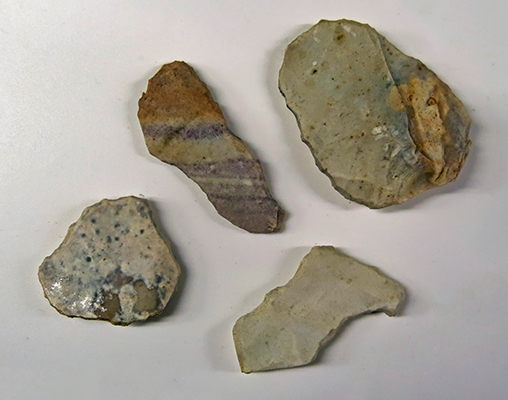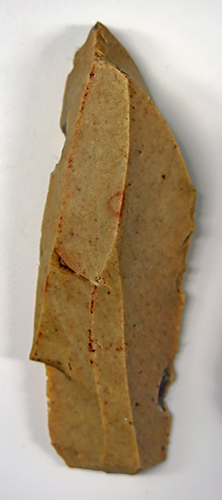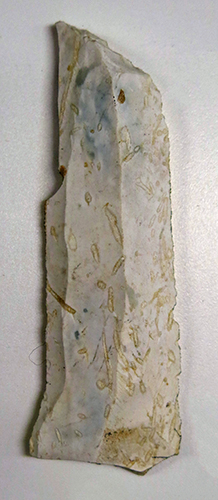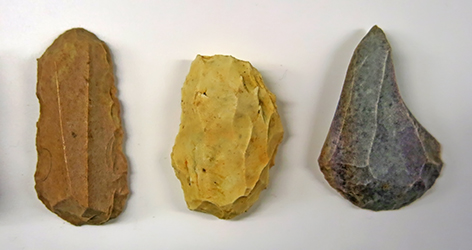Back to Don's Maps
 Back to Archaeological Sites
Back to Archaeological Sites Badegoule
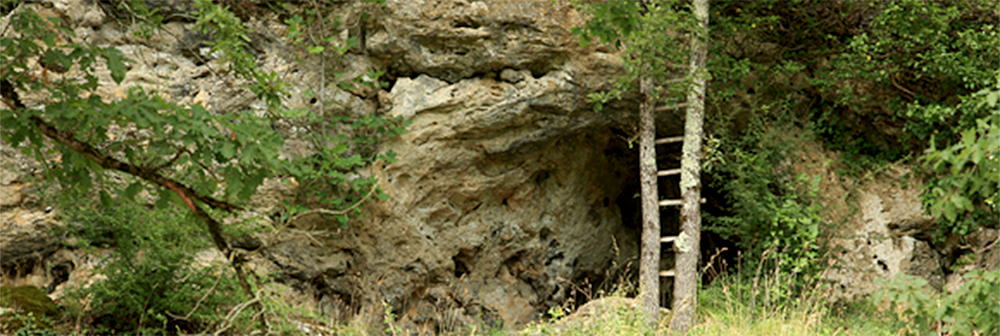
Grotte de Badegoule - a site which spans the Solutrean and the start of the Magdalenian.
Photo: http://visites.aquitaine.fr/grotte-de-badegoule
The Badegoulian culture spans the Solutrean and the early Magdalenian, and has been dated to between 19 000 and 17 000 BP. The lithic industry includes laurel leaf points and shouldered points, as well as the small scrapers known as raclettes. Shells for jewellery were obtained from fossil sites, as well as from both Atlantic and Mediterranean beaches. The site of Badegoule (45°08' N, 1°12' E) is in the Lardin-Saint-Lazare commune at the base and the extremity of a limestone cliff facing south, on the left bank of a tributary of Le Cern brook. The site may have been a huge living place, covering a large surface on the slope of the present relief, at least 50 m long and 20 m deep.
Text above adapted from Wikipedia and Rosendahl et al. (2003)
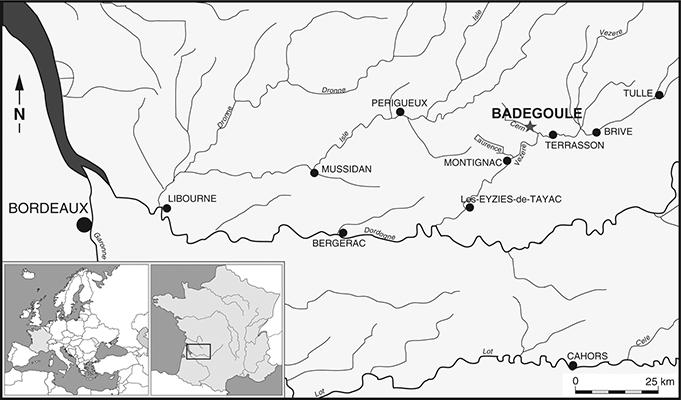
Location of the Badegoule site, Lardin-Saint-Lazare commune, Dordogne .
Photo: Drawing M. Seurin, UMR 5809 CNRS
Source: Rosendahl et al. (2003)

A Badegoulian site.
Photo: Don Hitchcock 2014
Source: Display, Musée d'Archeologie Nationale et Domaine, St-Germain-en-Laye
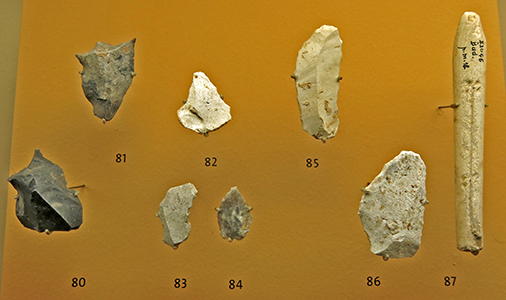
Layers VII and VI: Badegoulien
80 and 81: Perçoirs multiples, tools with multiple drill points fashioned on them.
82 to 86: Raclette (see below).
87: spear point with a groove.
Photo: Don Hitchcock 2014
Source: Original, Musée d'Archeologie Nationale et Domaine, St-Germain-en-Laye
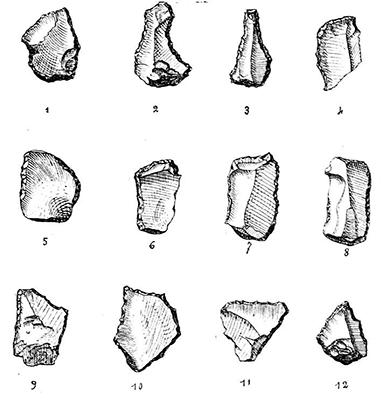
A raclette is a small flint flake, from 20 mm to 30 mm in diameter, and from 4 mm to 5 mm in thickness. One side is almost flat, usually with a clear bulb of percussion. The retouch may be on one side, two sides, three sides, but more usually all the way round. The name raclette was given to them by Cheynier (1930).
Their main purpose was to scrape wooden baguettes to shape, for smoothing wood, and for the removal of bark. They are only seen in the early Magdalenian.
Photo and text: Cheynier (1930)
Badegoulian raclettes, scrapers, Les Jean-Blancs (Les Jamblancs), Bayac (24)
Flint, Inv. no. 60.476.66 and 132
Photo: Don Hitchcock 2015
Source: Original, Musée d'Aquitaine à Bordeaux
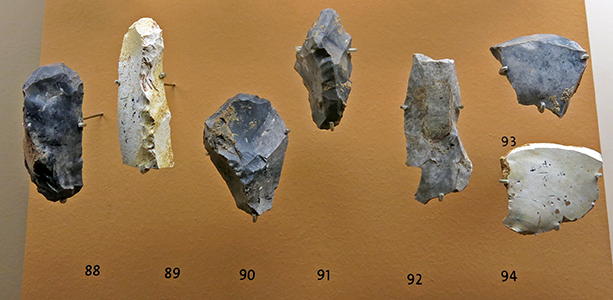
Layers VII and VI: Badegoulien
88 to 91: Grattoir.
92, 93, 94: Burin.
Photo: Don Hitchcock 2014
Source: Original, Musée d'Archeologie Nationale et Domaine, St-Germain-en-Laye
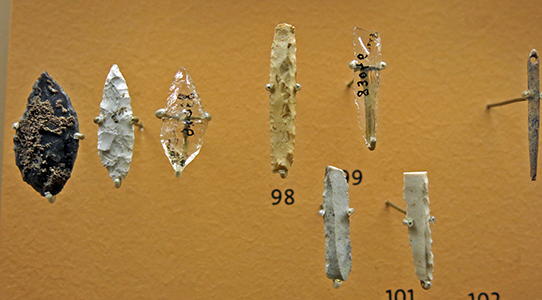
Layers V to 1: Solutrean
Three leftmost tools: Leaf point.
98 to 101: Backed blade.
Far right: Eyed needle.
(note, however, the exquisite and unique rock crystal blade at 99. It is so thin, flat, transparent and beautifully made that you could read a newspaper through it - Don )
Photo: Don Hitchcock 2014
Source: Original, Musée d'Archeologie Nationale et Domaine, St-Germain-en-Laye
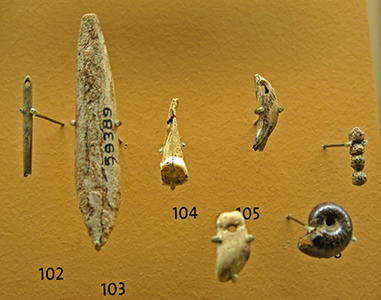
Layers V to 1: Solutrean
Far left: Eyed needle.
Second left: Spear point with a simple (not forked) base.
Next four: pendants of teeth and shell.
Far right: carved bone.
Photo: Don Hitchcock 2014
Source: Original, Musée d'Archeologie Nationale et Domaine, St-Germain-en-Laye
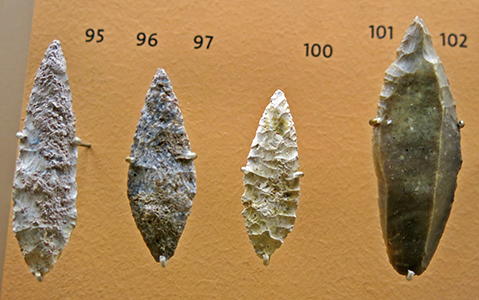
Layers V to 1: Solutrean
Left three: Laurel leaf points.
Far right: Flat faced point.
Photo: Don Hitchcock 2014
Source: Original, Musée d'Archeologie Nationale et Domaine, St-Germain-en-Laye
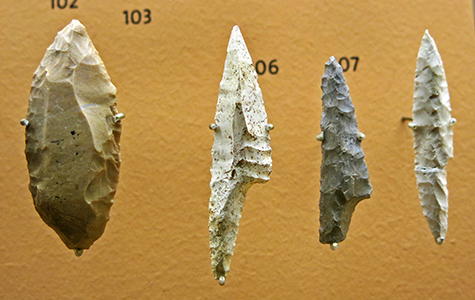
Layers V to 1: Solutrean
Left: Flat faced point.
Right three: Pointe à cran, shouldered point.
Photo: Don Hitchcock 2014
Source: Original, Musée d'Archeologie Nationale et Domaine, St-Germain-en-Laye
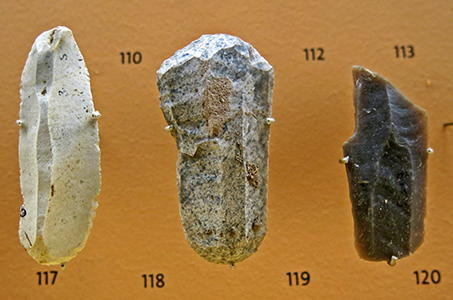
Layers V to 1: Solutrean
Left: Grattoir.
Centre: Double grattoir.
RIght: Burin.
Photo: Don Hitchcock 2014
Source: Original, Musée d'Archeologie Nationale et Domaine, St-Germain-en-Laye
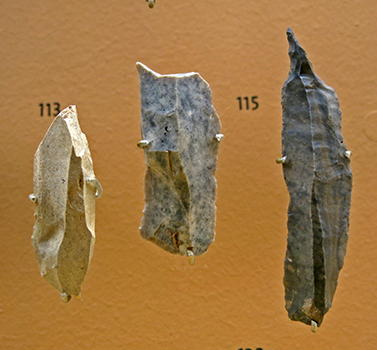
Layers V to 1: Solutrean
Left and centre: Burin.
Right: Perçoir, drill.
Photo: Don Hitchcock 2014
Source: Original, Musée d'Archeologie Nationale et Domaine, St-Germain-en-Laye
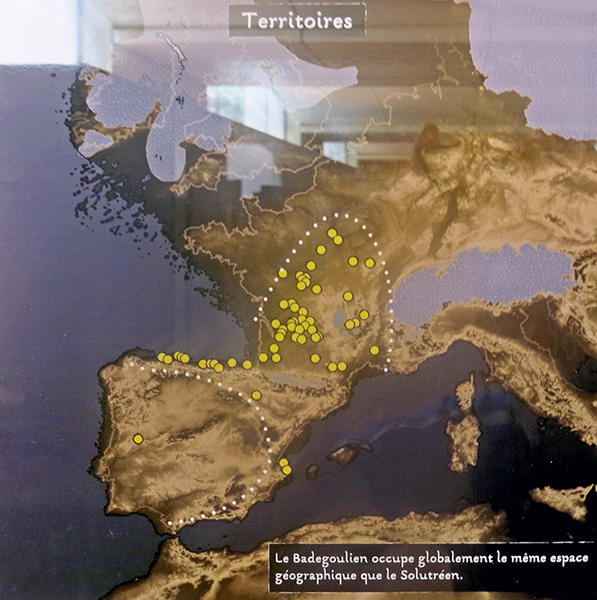
The Badegoulian culture occupied the same geographical area as the Solutrean culture.
Photo: Don Hitchcock 2014
Source: Display, Musée d'Archeologie Nationale et Domaine, St-Germain-en-Laye
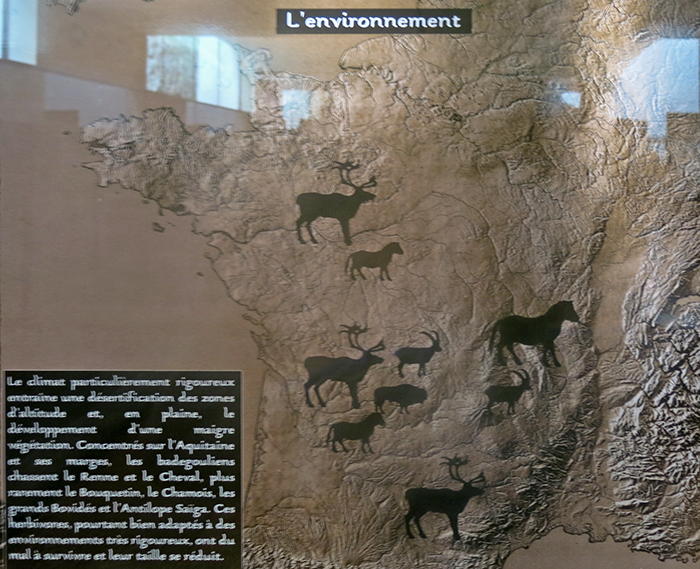
The particularly rigorous climate during the Badegoulian brought desertification to zones of higher altitude, and the lower plains saw the development of sparse vegetation.
Concentrated on the Aquitaine and its margins in south west France, the Badegoulians hunted reindeer and horses, and, more rarely, ibex, chamois, aurochs, bison, and the saïga antelope.
These herbivores, however well adapted they were to these very harsh environments, struggled to survive, and their size was reduced accordingly.
Photo: Don Hitchcock 2014
Source: Display, Musée d'Archeologie Nationale et Domaine, St-Germain-en-Laye
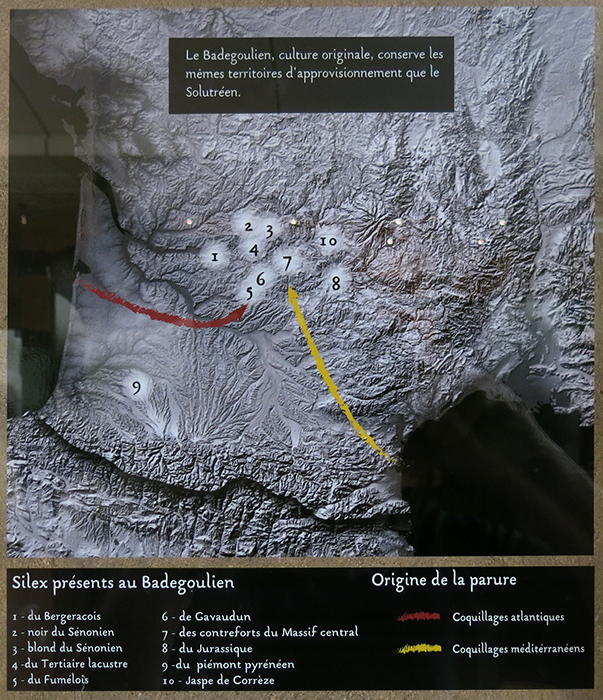
Origin of Badegoulian flint and shells.
Photo: Don Hitchcock 2014
Source: Display, Musée d'Archeologie Nationale et Domaine, St-Germain-en-Laye
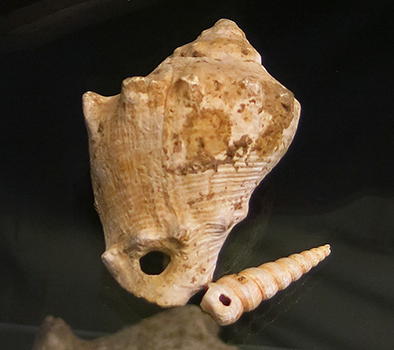
Badegoule perforated shells.
Photo: Don Hitchcock 2014
Source: Musée d’art et d’archéologie du Périgord, Périgueux
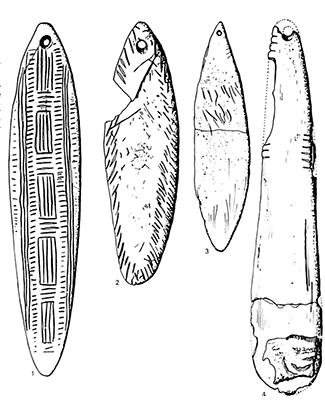
Bullroarers
1. Magdalenian; La Roche, Lalinde, Dordogne. Length 180mm.
2. Magdalenian; Abri de Laugerie Basse, Les Eyzies-de-Tayac. Length 107mm.
3. Solutrean; Lespugue, Haute Garonne. Length 90mm.
4. Solutrean; Badegoule , Dordogne. Length 190mm.
Photo: Dauvois (1989)
Source and text: Morley (2003)
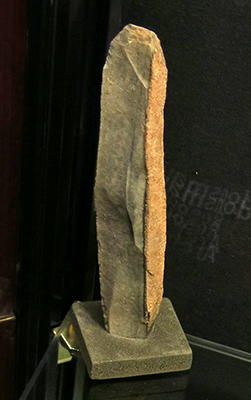
Badegoule grattoir.
This type of scraper, a grattoir on the end of a blade, constitutes 70% of the grattoirs found at Badegoule, according to Cheynier (1939)
Photo: Don Hitchcock 2014
Source: Musée d’art et d’archéologie du Périgord, Périgueux

This tool is hard to categorise - it has features of a point, a burin and a scraper.
Photo: Don Hitchcock 2014
Source: Musée d’art et d’archéologie du Périgord, Périgueux

Badegoule shouldered points, (pointes à cran) and laurel leafed points.
Photo: Don Hitchcock 2014
Source: Musée d’art et d’archéologie du Périgord, Périgueux
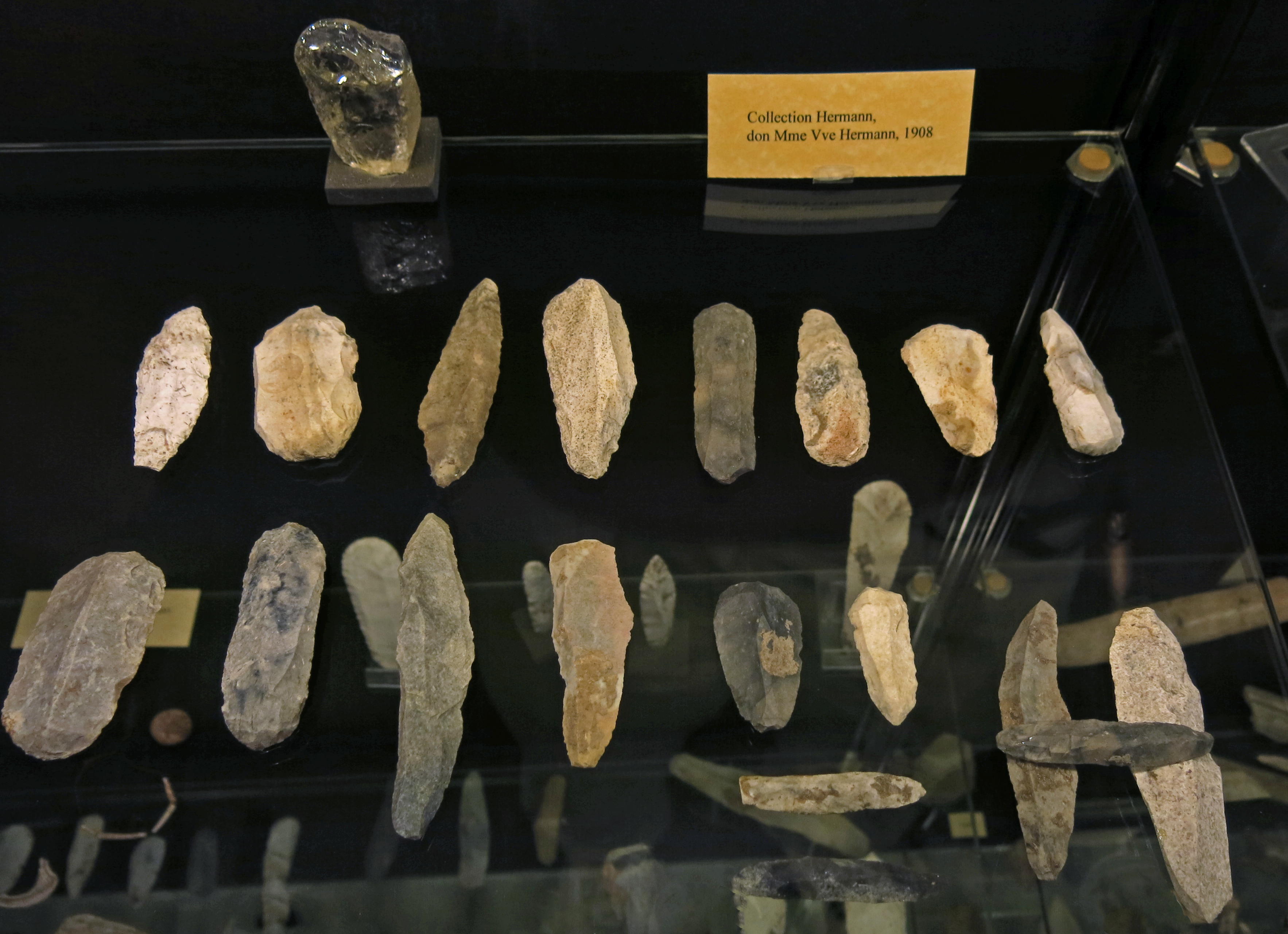
Badegoule scrapers and blades, with a rock crystal piece at the back.
Photo: Don Hitchcock 2014
Source: Hermann Collection, Musée d’art et d’archéologie du Périgord, Périgueux
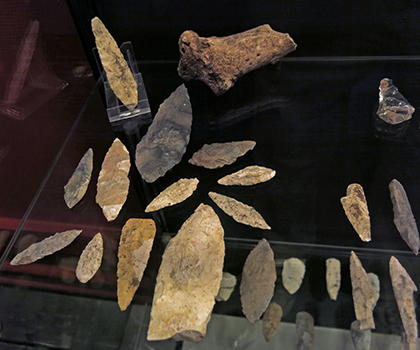
Laurel leaf blades, with some shouldered points on the right of the image.
Photo: Don Hitchcock 2014
Source: Musée d’art et d’archéologie du Périgord, Périgueux
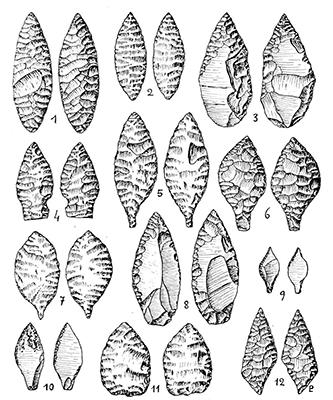
Solutrean of Badegoule.
Laurel leaf blades: 1 to 8, 11 and 12.
Fléchettes : 9 and 10.
Photo: Pradel (1957)

Pointes à cran (shouldered points), and some rock crystal pieces.
Photo: Don Hitchcock 2014
Source: Musée d’art et d’archéologie du Périgord, Périgueux
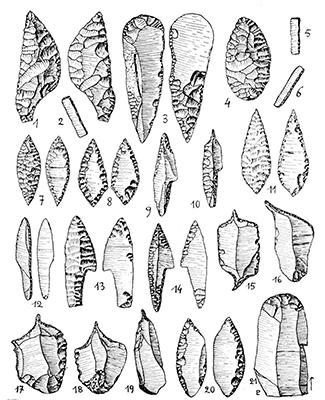
Solutrean of Badegoule.
Laurel leaf blades: 1, 4, 7, 8, 11, 20.
Shouldered points: 9, 13, 14.
Drills : 10, 15 to 19.
End scrapers: 3, 21.
Blades with a blunted edge: 2, 5, 6, 12.
Photo: Pradel (1957)
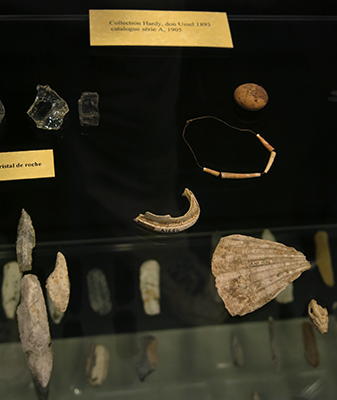
Pointes à cran (shouldered points), rock crystal pieces, and jewellery, including Dentalium shells, long tubes often threaded as part of a necklace. These Dentalium shells were available both from fossil sites and as shells washed up on beaches.
Photo: Don Hitchcock 2014
Source: Hardy Collection, catalogue série A, 1905, Musée d’art et d’archéologie du Périgord, Périgueux
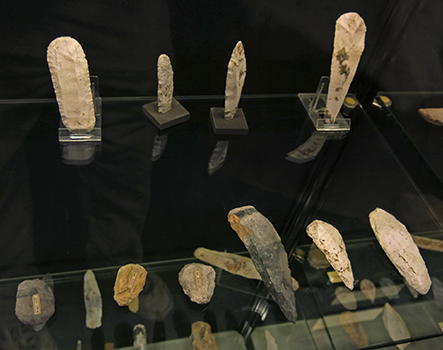
This selection is dominated by the superb scraper on the left, made on a well crafted blade with great skill, and able to be used on all four sides.
The other pieces are nondescript scrapers and a laurel leaf blade.
Photo: Don Hitchcock 2014
Source: Musée d’art et d’archéologie du Périgord, Périgueux
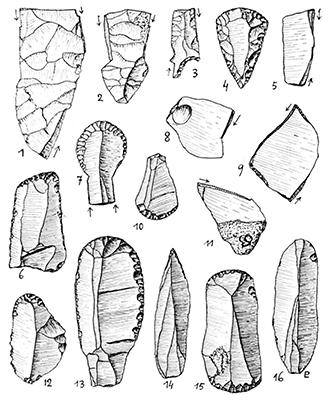
Solutrean of Badegoule.
Various burins : 1, 2, 3, 5, 8, 9, 11.
End scraper : 4, 6, 7, 10, 12, 13, 15.
Blades : 14, 16.
Photo: Pradel (1957)
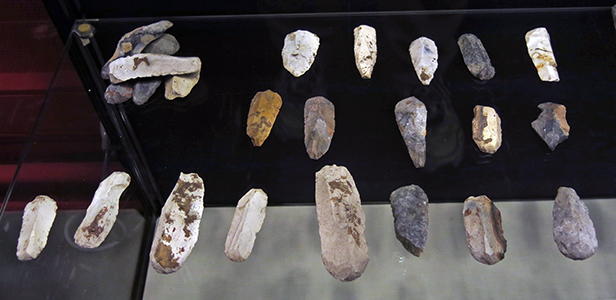
Scrapers.
Photo: Don Hitchcock 2014
Source: Musée d’art et d’archéologie du Périgord, Périgueux
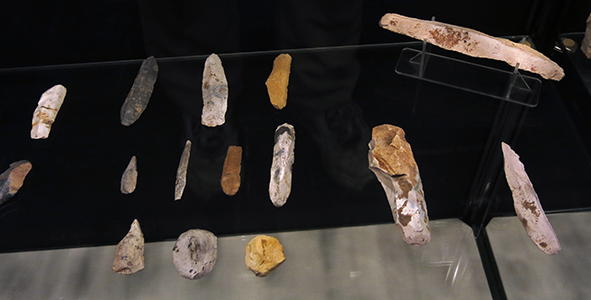
Scrapers.
Photo: Don Hitchcock 2014
Source: Musée d’art et d’archéologie du Périgord, Périgueux
Badegoulian tools from other sites

Badegoulian bone awls, from Les Jean-Blancs, Bayac.
Albert Coste collection.
Photo: Don Hitchcock 2015
Catalog: 60.476.1, 60.476.2
Source: Original, Musée d'Aquitaine à Bordeaux
Badegoulian burins, Moulin de Pourquey, Castelviel (33)
Flint, Inv. no. 2006.17.15.2, 2006.17.15.3
( note the fossil inclusions in the burin on the right, possibly sponge spicules - Don )
Photo: Don Hitchcock 2015
Source: Original, Musée d'Aquitaine à Bordeaux
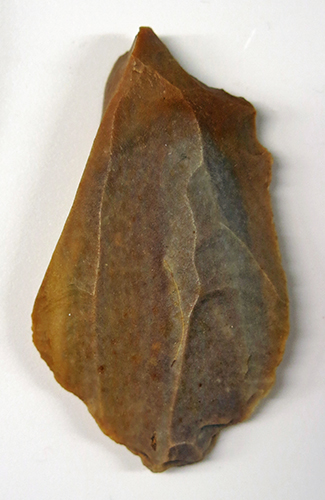
Badegoulian tool
( This undescribed tool is probably a burin - Don )
Flint
Photo: Don Hitchcock 2015
Source: Original, Musée d'Aquitaine à Bordeaux
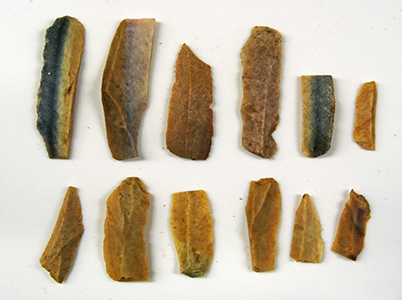
Badegoulian lamelles, blades, Moulin de Pourquey, Castelviel (33)
Flint, Inv. no. 2006.17.15.14 to 2006.17.15.25
Photo: Don Hitchcock 2015
Source: Original, Musée d'Aquitaine à Bordeaux
Badegoulian lamelles, blades, Moulin de Pourquey, Castelviel (33)
Flint, Inv. no. 2006.17.15.14 to 2006.17.15.25
Photo: Don Hitchcock 2015
Source: Original, Musée d'Aquitaine à Bordeaux
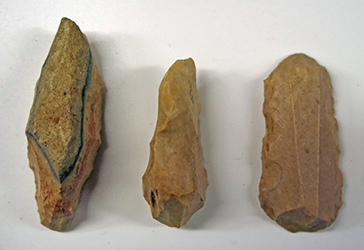 Grattoir, scraper, Moulin de Pourquey, Castelviel (33)
Grattoir, scraper, Moulin de Pourquey, Castelviel (33)
Flint, Inv. no. 2006.17.15.4 to 2006.17.15.8
Photo: Don Hitchcock 2015
Source: Original, Musée d'Aquitaine à Bordeaux
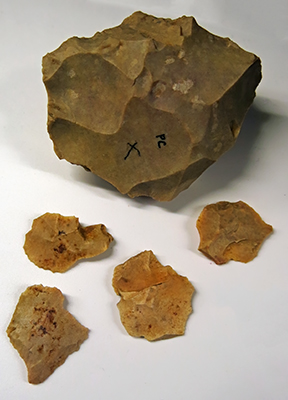
Nucleus and flakes, Moulin de Pourquey, Castelviel (33)
Flint, Inv. no. 2006.17.15.8 to 2006.17.15.13
Photo: Don Hitchcock 2015
Source: Original, Musée d'Aquitaine à Bordeaux
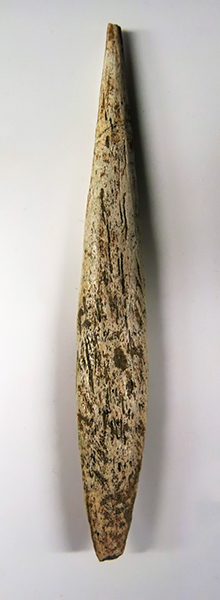
Sagaie, spear point, Les Jean-Blancs (Jamblancs), Bayac (24)
Bone, Inv. no. 60.476.71
Photo: Don Hitchcock 2015
Source: Original, Musée d'Aquitaine à Bordeaux
References
- Cheynier A., 1930: Un outil magdalénien nouveau, en silex à Badegoule - La Raclette, Bulletin de la Société préhistorique de France,1930, tome 27, N. 10. pp. 483-488.
- Cheynier A., 1939: Le Magdalénien Primitif de Badegoule. Niveaux à Raclettes, Bulletin de la Société préhistorique de France,1939, tome 36, N. 9. pp. 354-396.
- Dauvois M., 1989: Son et Musique Paléolithiques, Les Dossiers D'Archéologie, Vol. 142, p. 2-11.
- Morley I., 2003: The Evolutionary Originsand Archaeology of Music, Darwin College Research Report, DCRR-002, ISSN 1749-9194
- Pradel D., 1957: Le Solutréen de Badegoule. Documentation complémentaire, Bulletin de la Société préhistorique de France, 1957, tome 54, N. 10. pp. 600-605
- Rosendahl W., Maureille B., Trinkaus E., 2003: Rediscovery of the Badegoule 5 skeletal remains (Badegoule, le Lardin-Saint-Lazare, Dordogne, France), Paléo, 15 | 2003, pp. 273-278
Back to Don's Maps
 Back to Archaeological Sites
Back to Archaeological Sites
